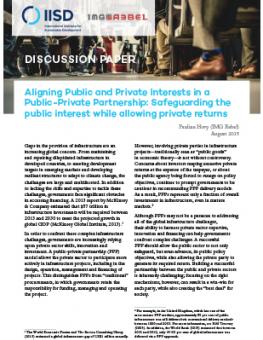
Aligning Public and Private Interests in a Public-Private Partnership: Safeguarding the public interest while allowing private returns
Involving private parties in infrastructure projects—traditionally seen as “public goods” in economic theory—is not without controversy.
Concerns about investors reaping excessive private returns at the expense of the taxpayer, or about the public agency being forced to renege on policy objectives, continue to prompt governments to be cautious in recommending PPP delivery models. As a result, PPPs represent only a fraction of overall investments in infrastructure, even in mature markets. Although PPPs may not be a panacea to addressing all of the global infrastructure challenges, their ability to harness private sector expertise, innovation and financing can help governments confront complex challenges. A successful PPP should allow the public sector to not only safeguard, but even advance, its public policy objectives, while also allowing the private party to generate its required return. Building a successful partnership between the public and private sectors is inherently challenging; focusing on the right mechanisms, however, can result in a win-win for each party, while also creating the “best deal” for society.
This paper was funded by the Danish International Development Agency (DANIDA).
You might also be interested in
Monitoring Progress in Green Public Procurement
This report outlines the importance of monitoring progress in green public procurement (GPP) and highlights various methodologies, challenges, and recommendations.
Gender Equality at the Heart of Recovery: Advocating for Gender-Responsive Procurement in Ukraine
Ukraine is already preparing for reconstruction, which will cost an estimated USD 411 billion and take at least 10 years. The integration of gender considerations into public procurement processes could generate greater inclusivity in a rebuilt Ukraine.
A Sustainable Asset Valuation of Non-Motorized Transport in Coimbatore, India
A Sustainable Asset Valuation (SAVi) of the economic, social, and environmental benefits of a non-motorized transport (NMT) network in Coimbatore, India.
FAQ: Legal Considerations When Using the CO2 Performance Ladder in Public Procurement
This report answers frequently asked questions about the legal aspects of using the CO2 Performance Ladder as a green public procurement tool.